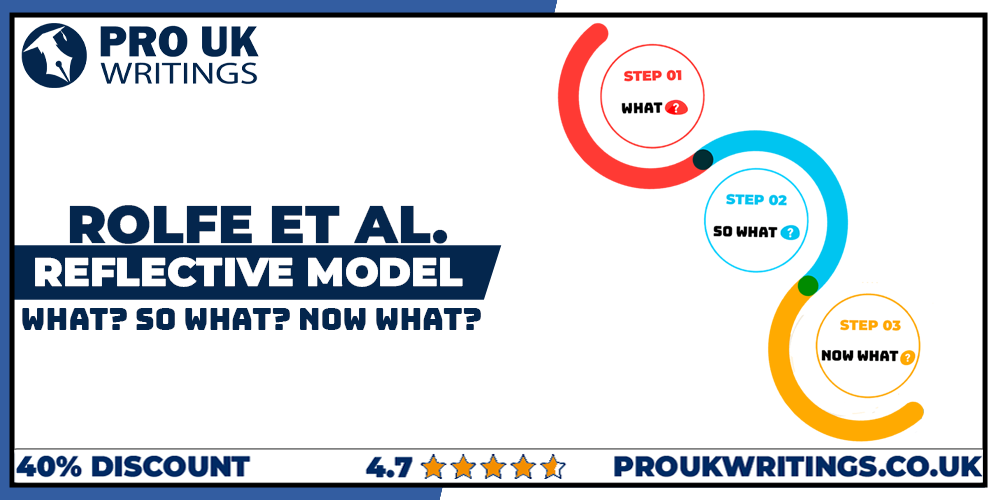WHAT? SO WHAT? NOW WHAT?
Are 3 primary questions used in Rolfe et al. model which allows practitioner to consider the past events that went wrong in “ What? ” phase, then determining and compensating them in “ So What? ” phase and then finally executing the learnt principles in “ Now What? ” phase.What is the Rolfe et al. model?
In 2001 professor Gary Rolfe along with Dawn Freshwater & Melanie Jasper developed the model of reflection commonly is known as the Rolfe et al. model of reflection the model was developed for nursing students to have an insight of their experience, feelings and actions to develop their educational practice accordingly, because the model aims at 3 significant prime questions (What? So What? & Now What?) which permits an individual to have an interpretation of an event, observing the situation and coming with prospect for future events you can see the visual presentation of how this principle works down below:How Rolfe Reflective Model Help?
This model help practitioners with the reflective writing by crucially examining the past events with the question of what? Scrutinizing the things that went fiasco which led them to question in present so what? Which usually results in for practitioners to come with the solution for the dilemma in 3rd execution phase of the model now what? before making the observational theory about the situation they incept with emphasizing the problem and then implement the model to come up with solution.
Fundamentals To Remember
How to use Rolfe Reflective Model model?
While doing your reflective writing make sure to use references, choosing Rolfe reflective model you can implement many of your references in the “What?” section. why references are fundamental and what do we mean by references in Rolfes reflective model? By references we mean by determining and imperatively examining the past events that went horribly wrong because of the certain way you acted out upon the situation stowing this model into the situation will refer to why did you act that way? In your “Now what?” Section thinks about the possibilities that you could utilize to make the situation better instead of regrets strategize the possibilities of doing better which will eventually lead you out to the execution phase of the model “Now what” where you will bring your ideas of square one to projection.
Keeping it formal
When-ever you write about personal experiences it usually gets very conversational and chatty format of writing make sure you keep the professionalism while writing about your experience be adamant of the noun verifiable truth that your reflective writing is academic and formal.
Who was the inventor of Rolfe reflective model of what? So what? Now what?
Well so now that you know very well how does this reflective model work and what purposes it serves for nursing practitioners you must think of Rolfe et.al ( Rolfe’s reflective model ) as a brilliant brain at hind end of this masterpiece but do you really know who originated this model legitimately? Well it wasn’t Rolfe et al reflective model in (2001) but it was Terry Borton ( Bortons model of reflection ) in 1970 who was the real mastermind behind this concept Terry Borton’s reflective model was first introduced in his published book of “Reach, Touch and Teach” in the book he calls it as “What? So what? And Now What? Method, but this method was also published by 2 other professors with differentiation of time period Rolfe et. al in (2001) and by Driscoll model of reflection 2007.

Sebastian James
Blog Author
Meet Mister Sebastian James who is an accomplished academic writer, who holds great credentials in various different faculties of academic writing having the degree of doctorates. Mr. Sebastian James is the original author all of the content written on this website with great knowledge of academics Mr. Sebastian James is the original upfront writer for Pro UK Writings.
FAQs
Find Solutions of your queries
The use of Rolfe et. al model results in practitioner’s clarity of blurred vision of the circumstances that took their place in past it helps an individual to understand the situation better by examining the complexities of the things that did not workout.
The purpose for this model was to aid practitioners in nursing or related fields to have an insight of their experiences, feelings and actions in regards of performing better in future to compensate for the times their actions were not appropriate which resulted in failure.
Reflective writing is a lot different from casual normal writing in reflective writing you pen down your personal experiences so individuals usually end up being too chatty about their situations it is common mistake which results in informal writing.
The Rolfe et. al model is made up of 3 primary questions “What?”, “So What?” & “Now What?” without these questions there is no Rolfe et. al model.
Et. al is basically an abbreviation for the Latin term “et alia” which legitimately means “and others” if we write down Rolfe et. al in elaborated format then it will be “reflective model of Rolfe and others”
John Driscoll’s reflection model helps nursing practitioners to understand their experiences better Driscoll reflective model has helped many nursing students to perform better in their faculties because Driscoll’s model of reflection cycle consists of 3 phases of examining resolving and executing.
Rolfe et. al is a model of reflection designed in 2001 by Gary Rolfe it justifies the reflection process with 3 simple questions What? So What? Now What?
Driscoll model of reflection can be used in different situations to come up with better substitute for dilemmas by implementing 3 simple steps of interpreting what happened? analyzing the entire situation and then anticipating the execution of solution for better possibilities in future.

